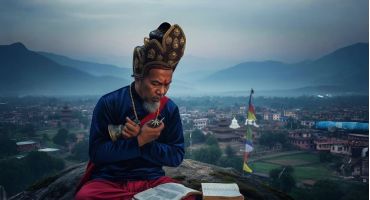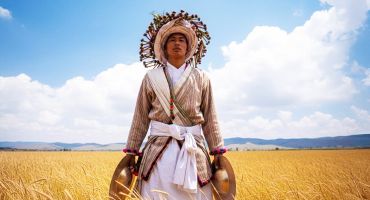Festivals in the Himalayas have always been a medium through which tribal communities expressed their understanding of the world. It allows them to assert their actions and reactions to social, natural, and environmental circumstances. The idea here is to claim indigenousness and celebrate festivals that have been informed by local sensibilities, practices, and perceptions. For the Newars, this idea is articulated in a way that seems indigenous instantly but where the influence of Hinduism is also largely dominant. Or at least their interpretations are!
Over the many centuries of its journey, Newari traditions have meandered along with a series of religious practices. While these practices are exclusive only to the Himalayas they still have absorbed influences along the way. Perfect examples are set around the Kathmandu region, like the “Ghanta Karna” festival.
Ghanta Karna, often known as Gathemuga or Gathemangal was a ruthless monster who mercilessly killed his victims and was particularly notorious for picking up children and killing them. Ghanta Karna means “Bell Ears”. On each ear, he wears a bell that jingles as he walks. He does that so he can avoid the chants made in the names of the Gods. His depraved sexual orgies and appalling overindulgences with his innumerable wives horrified the pious people of the Kathmandu valley. This festival is about burning the effigy of the monster Ghanta Karna, a manifestation of evil energies, and burning him cleanses the land and helps rejuvenate the spirit of the living.
In Newari belief systems, men and women being haunted by evil spirits, demons, and witches aren’t unfathomable. These spirits, good or bad, roam the lands and even visit homes. In Newari society, the existence of the evil eye, the practitioners of black magic and spells are not considered irrelevant or sources of mere superstition. The festival of Gathemangal, therefore, is still significant to the Newars. The festival falls on the fourteenth day of the dark lunar fortnight in July or early August, which is traditionally the last day of rice transplanting. This is the Night of the Devil when Nepalese celebrate their victory over the most dreaded of all monsters who terrorized the countryside in ancient times.

It is said that the tormented people held a great meeting and together prayed to the old Gods for help. One God complied, appearing amongst them in the guise of a common frog. The frog approached Ghanta Karna and started to imitate and mimic every move of the monster. Enraged at the creature’s insolence, Ghanta Karna leaped towards it, but the frog jumped beyond his reach and jumped into a well, and the monster, thinking victory was his, plunged in after and met his death. Then in a festive procession, the people dragged the gigantic, corpse of the monster to the river for cremation, throwing his ashes into the water, and there was peace in the land again.
Gathemangal festival is in honor of the frog but also about the defeat of the Ghanta Karna. On the day of this festival, in the morning, little children collect money from different homes and erect simple arches and cross made up of tree twigs at the street intersections. They ask for money from all pedestrians who take this route-funds that are used to create a grand mock funeral of the devil. This is done to recreate the funeral of Ghanta Karna where his wives had to enlist little children to beg for funds to cremate their fiendish husband.
Ghanta Karna effigies, made up of bamboo and rice straw, are erected at crossroads around the city, the bordering villages as well, made from leafy bamboo poles, bound near the top to form a tall structure. A painted, frowning face of a monster is affixed to the body. At dusk, an eager crowd gathers around the bamboo effigy awaiting the untouchable Ghanta Karna. Then it is set on fire and dragged toward the river where a final farewell to the Devil is made. The ashes are thrown in the river.

Many Newars also associate the Gathemangal festival with Shinajya, where folklore narrates the story of ghosts and spirits helping the farmers of Kathmandu but these creatures couldn’t be fed enough and had to be burned or drowned. Some associate Ghanta Karna to the Aju Dyo, an incarnation of Lord Bhairav. Today, not much is known about when this festival began but its stories, approach, and performance are unique to Kathmandu and the Newars. The Ghanta Karna festival indicates beyond all doubt that cultural festivals endorse an experience of social inclusion, positive community engagement, and a way to preserve age-old traditions.
The Ghanta Karna festival is one of the few consistently positive events for indigenous Newars to assert a more positive view of themselves, both traditionally and for recognition as a distinct culture in a global context. It is a festival that is more cultural than a religious one, successfully inherited by today’s Newars from their forefathers which is why it is a significant event. Throughout the ages, such festivals have helped maintain cultural integrity and the transfer of tradition to a whole new generation of people.





Leave a Reply